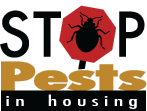Bed Bugs
How Do You Get Rid of Bed Bugs?
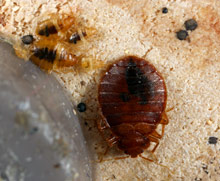 |
|
Adult, nymphs and blood spots on wood. Photo by Gary Alpert, Env. Health & Safety, Harvard U. |
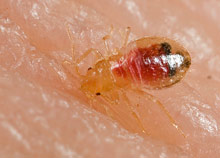 |
|
Bed bug nymph feeding. Photo by Gary Alpert, Env. Health & Safety, Harvard U. |
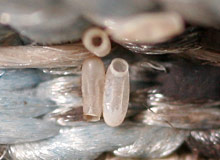 |
|
Bed bug eggs on mattress fabric. Photo by Gary Alpert, Env. Health & Safety, Harvard U. |
Bed bugs hitchhike on people’s belongings and hide in crevices near where they rest. To prevent an infestation of bed bugs, you need to keep them from coming into your home and detect new infestations early. Basically, no silver bullet exists. Pest control has changed and we are still working on the best solutions for bed bug management. Rely on the pest management professional (PMP) for all pesticide use. Focus on preventing introduction and detecting them early. Educate residents and staff about how to prevent bed bugs from hitchhiking on their belongings. Make sure procedures are in place for prompt and proper furniture removal from the property. Install mattress- and box-spring encasements and bed bug interceptors. Offer products and services for free to incentivize cooperation. Teach residents and staff to inspect often. If a unit is being treated for bed bugs, have a staff person check on the preparation progress before the pest management professional arrives.
Bed Bug Basics
What they look like
Adults look like apple seeds with legs. Young bed bugs—nymphs—look like adults, only smaller. Newly hatched nymphs are poppy seed-sized. Eggs are tiny, white, and hard to spot.
Where they live
In cracks and crevices of bed frames, floors, walls, furniture, electronics, mattresses—any spot they can wedge themselves near where people rest.
What they do
Feed on you as you sleep, but if you’re not around they can go over a year without food. Bites look like a rash or welts—or you may not notice them at all. Bed bugs don’t transmit disease.
How to deal with bed bugs
Don’t bring home hitchhikers: Working in an infested unit? Remember, bed bugs can’t jump or fly. And they spend a lot of time hiding. You’re likely to see them before they crawl on you. Don’t sit or set your equipment down near where people rest. If you have to move an infested object, wear a disposable suit and booties. Keep a change of clothes in your car, change at work, and dry your bed bug clothes for 20 minutes on high heat as soon as you get home.
Buying used furniture, bedding, clothes? Inspect thoroughly. Look for the bugs or the spots they leave behind. Wash and dry bedding and clothes with hot water and high heat. There are other heat options like steam too.
Detect before the infestation grows and spreads: Keep bedroom furniture an inch or two from the wall and a flashlight handy for easier cleaning and inspecting. Bed bug-proof mattress covers, light-colored bedding, and insect interceptors make them easier to spot. Offer professional services and bed bug products for free to incentivize cooperation.
Pesticide options: Leave it to the professionals. Some sprays simply repel bed bugs, spreading them around. Make sure pesticides are labeled specifically for bed bugs. Always read and follow the instructions on the label. The pros may ask the resident to prepare for bed bugs service. The preparation requirements should be least disruptive to the bed bugs and customized to each infestation—bed bug prep is not always time consuming.
This page “How Do You Get Rid of Bed Bugs” has been translated to Portuguese by Artur Weber. See the translation here: COMO SE LIVRAR DE PERCEVEJOS?
Resources
Policy and planning
- Federal Collaborative Strategy on Bed Bugs
- HUD Office of Housing’s Notice on Bed Bugs
- HUD Office of Public and Indian Housing Notice on Bed Bugs and related attachment
- Template Affordable Housing Bed Bug Plan
- Template Common Area Inspection Sheet
- Media Messaging Advice for Housing
- Bed Bug Best Management Practices from the National Pest Management Association
- Legal and Legislative Information from the National Pest Management Association
- “What’s Working for Bed Bug Control in Multifamily Housing” from the National Center for Healthy Housing
- Mattress Encasement Cost Comparisons Overview & Prices
- Information on bed bug sniffing dogs
- Discarded Furniture Warning Poster
- Many of the sites below have “How to Hire a Pest Control Company” factsheets.
Factsheets and educational resources
- Integrated Pest Management for Bed Bugs: A Property Manager's Guide
- Rutgers University’s Cost-effective and Money-wasting Bed Bug Control Methods
- Texas A&M Agrilife Extension’s How to Select a Bed Bug Control Provider
- BedBug Central’s Affordable Housing Resource Guide and Documents Package
- Quick Tips on Bed Bugs
- What Property Owners and Managers Need to Know about Bed Bugs
- Resources for Health Professionals
- How to Make a Bed Bug Interceptor Trap out of Common Household Items
- EPA’s Bed Bug Website
- Government of Ontario
- National Pest Management Association
- Safer Pest Control Project
- University of California
- Connecticut Coalition against Bed Bugs
- University of Florida
- Illinois Department of Public Health
- Purdue University
- University of Kentucky
- Michigan.gov (incl. color printable factsheets)
- University of Minnesota “Let’s Beat the Bug” (multilingual prevention & control information for landlords, tenants, and homeowners)
- New York City Dept. of Health and Mental Hygiene
- New York State IPM Program (pest mgt. step-by-step factsheets, English and Spanish)
- Central Ohio Bed Bug Task Force
- Virginia Dept. of Agriculture and Consumer Services (informative & action plan factsheets, English and Spanish)
- Bed Bug Infested Item Disposal
- Print and fill in the number you want residents to call on this bed bug poster (English or Español)
- General Bed Bug Poster
- Presentation for Libraries
- Presentation for Health Depts
- Bed bug posters in multiple languages:
Case studies
- Case study on property-wide engagement: Cultural sensitivity and respect set the tone for successful IPM implementation
Blogs
Videos
- University of California
- University of Florida (including DIY heat box video)
- Rutgers University Bed Bug Video Series
- NC Department of Agriculture
- Virginia Dept. of Agriculture and Consumer Services (English and Spanish)
- University of Minnesota (multilingual videos)
- They’re Back (CT Agricultural Experiment Station)
- Bed Bug TV (BedBug Central)
- Purdue University How-to Videos
- Minneapolis DIY Video Series
- The Tenant’s Role in IPM
Resident Materials
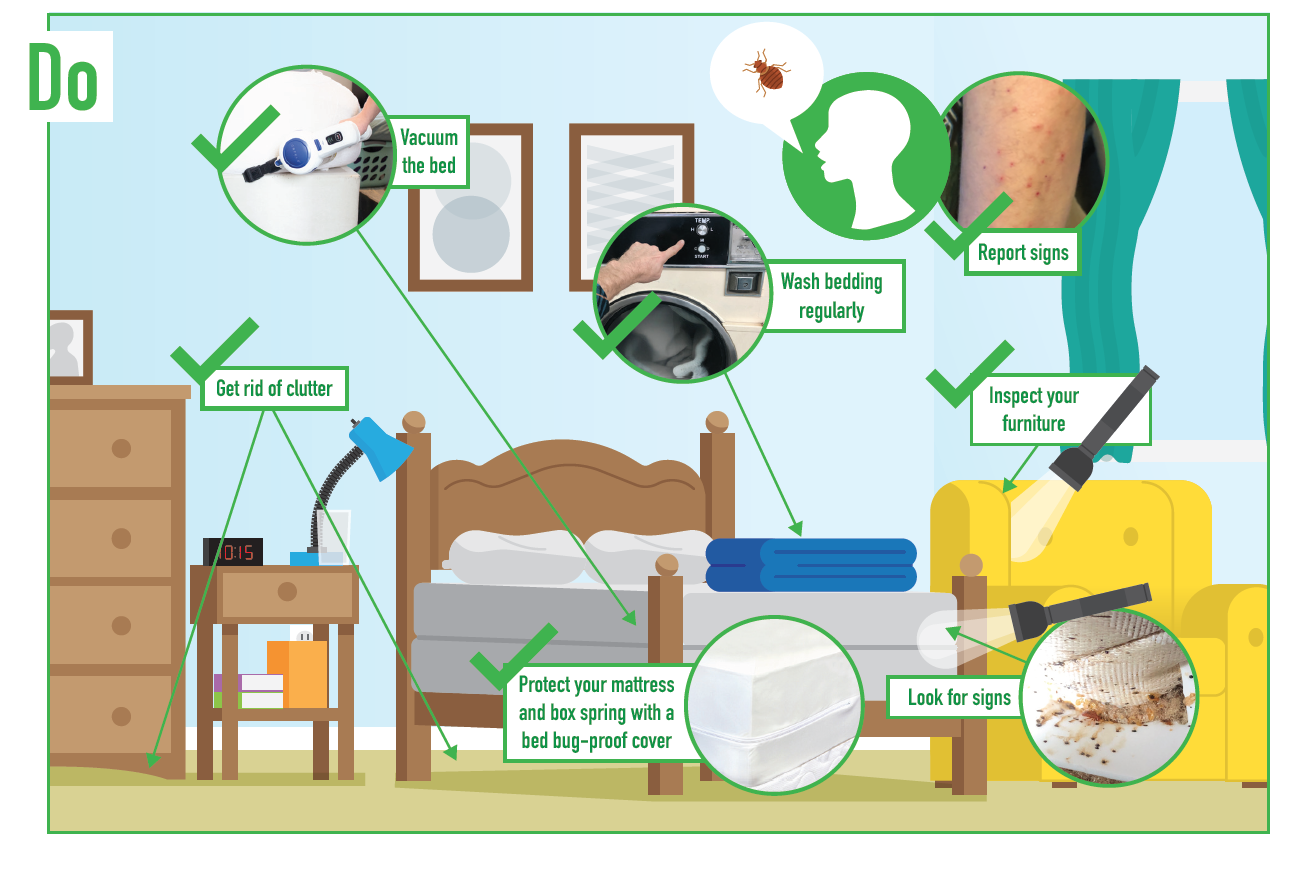 |
|
Use picture-based materials to communicate with residents like the “Stop Bed Bugs!” guide pictured above. |
- Stop Bed Bugs! picture-based guide from StopPests
-
Spanish: Detenga las Chinches!
-
- How to Make a Bed Bug Interceptor Trap out of Common Household Items
- Discarded Furniture Warning Poster
- NYSIPM bed bug factsheets
Complete guide, Steps 1–7 English
Complete guide, Steps 1–7 Spanish- Step one: Inspection
English, Spanish - Step two: Eliminate clutter
English, Spanish - Step three: Vacuum
English, Spanish - Step four: Clean mattress and bed frame
English, Spanish - Step five: Heat treat & wash
English, Spanish - Step six: Make your bed an island
English, Spanish - Step seven: How to dispose of an infested mattress
English, Spanish - Dealing with bed bugs
English, Spanish - Preparing for a visit from a pest management professional
English, Spanish - Tips for travelers
English, Spanish
- Step one: Inspection
Northeastern IPM Center
See results from the Northeastern IPM Center’s resources database
FAQ - About Bed Bugs
Are IGR not really effective for bed bugs?Are there any seasons that are worse for bed bugs?
Can you recommend some bed bug monitors?
Do bed bug products have residual killing action?
Do bed bugs carry disease?
Do bed bugs feed on pets?
Do pesticides work on both cockroaches and bed bugs?
Do you have any products that you recommend for bed bug treatments?
Does poor sanitation attract bed bugs?
Have there been any instances of staff bringing bed bugs home?
How can bed bug infestations get started other than being brought in from active locations?
How do I confirm the bed bugs are gone?
How do these pitfall traps work in detail? What causes the bed bug to climb into the trap?
How do we battle the stigma associated with bed bugs?
How do you get rid of bed bugs?
How effective is organic or green pest control for bed bugs?
How long should a bed bug treatment take?
Is Freezing effective?
Is it true that self-treating counteracts pest control chemicals?
Lowering Costs with an In-House Bed Bug Management Plan (VTech Bed Bug Webinar)
Bed Bugs Training Opportunities
Lowering Costs with an In-House Bed Bug Management Plan (VTech Bed Bug Webinar)Bed Bug Webinars
